
JULIA LEE BARCLAY-MORTON – YOGA, WATER AND REWRITING AUTISM
I interviewed writer Julia Lee Barclay-Morton about her experience of autism. Julia began as an experimental dramatist in New York, moving to the UK to
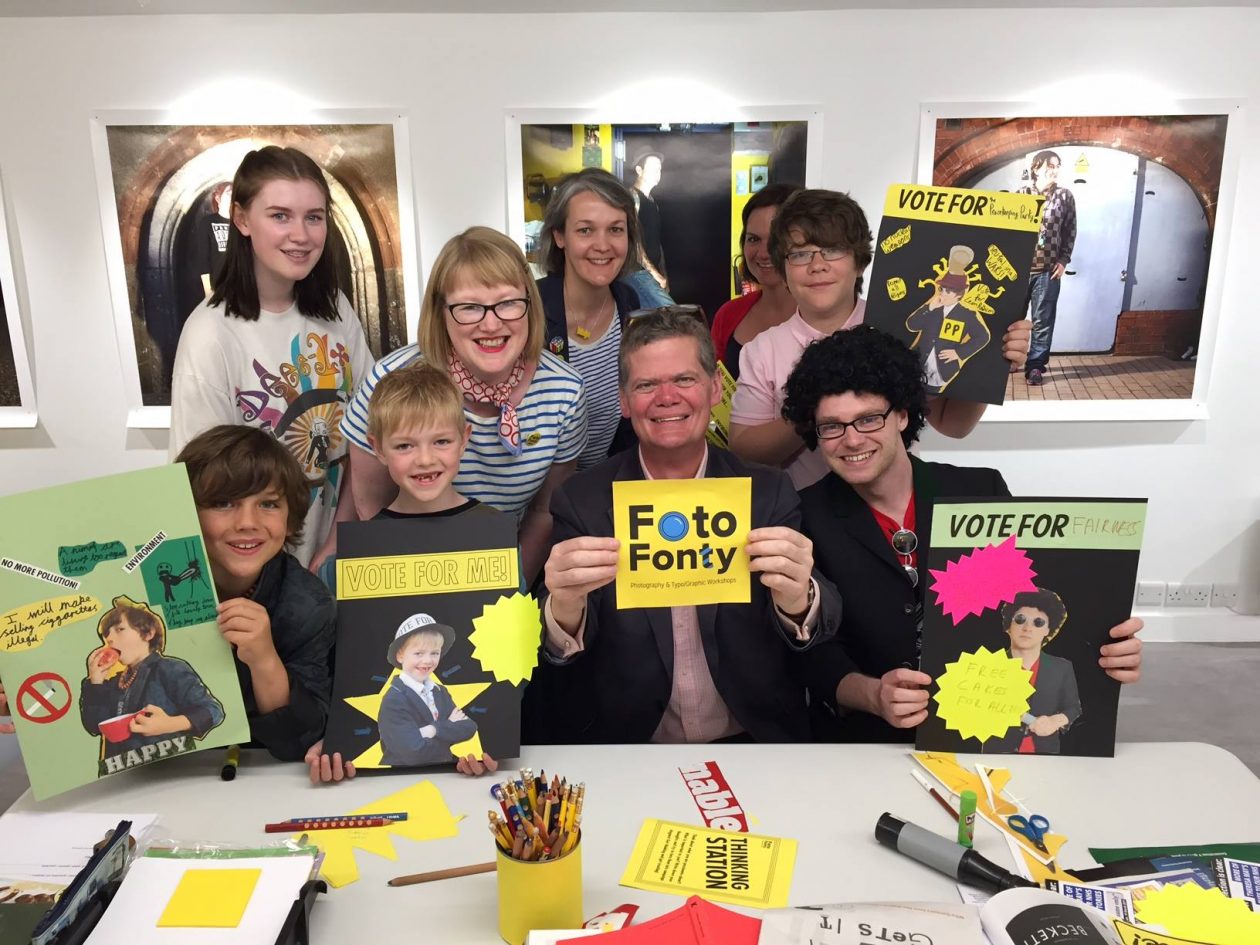

I invited writer and producer Amy Zamarripa Solis to guest blog about the ‘City of Culture’ arts-led type of regeneration seen recently in Margate, Folkestone, Liverpool and Brighton. Amy responded with a piece about the new Eastbourne Devonshire Collective venues where she is a key player. Amy also runs the arts organisation Writing Our Legacy and her own arts management / production company This Too Is Real.
Amy writes:
‘Arts-led regeneration is a tough subject in the UK these days. Not just because of austerity, Brexit and shrinking local authority budgets.
The arts themselves have recently come under fire as they’re used to help improve local communities and economies. Whereas gentrification used to be the dirty word, now it is ‘art washing’. In Brixton, you can buy your dinner from a shipping container, and in Manchester, you can sup cocktails via a clandestine route through to a laundrette.
Not all arts initiatives, however, are superficial and slapdash or ignore local communities and their needs. Arts and culture-led regeneration can make a lasting difference.
Real arts-led regeneration, working with local people and local businesses can improve people’s lives and livelihood. We have seen arts and culture transform towns and cities such as Margate, Folkestone, Liverpool and my home until recently, Brighton.
During the 1970s and 80s, Brighton was a small hippy artist community. By the time I reached it, in the late 90s and 00s, Brighton was awash with trustafarians, BMWs and DFLs (down from London). It was dubbed ‘London by the sea’.
Now? Brighton seems to have tripled in population in the space of a year. It’s too busy, too packed, all of the pubs spill out on the street.
What made it so popular? My theory is that it is the underlying artist community and arts infrastructure– with Brighton Festival and the myriad of amazing arts organisations based there – that has led to its successful regeneration.
With Brighton as expensive to live in as London, eyes are poised further down the coast, to ‘God’s waiting room’ Eastbourne, Bexhill, and its ever-hip, trendier-than-thou neighbours St Leonards and Hastings.
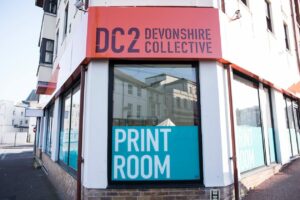 For the past year, I have been working with a new social enterprise – Devonshire Collective – to help regenerate Eastbourne’s most deprived and most diverse neighbourhood through arts and culture.
For the past year, I have been working with a new social enterprise – Devonshire Collective – to help regenerate Eastbourne’s most deprived and most diverse neighbourhood through arts and culture.
Seaside Road and Seaside are a stone’s throw from the beach and Eastbourne’s Victorian Pier and home to ethnic eateries and shops including Polish, Portuguese, Spanish, Turkish, Italian, Persian, Iraqui and more. Formerly Eastbourne’s high street at the turn of the century, our street is a lively hub for the community by day, a mecca for night time dining.
At the heart of the venture are three former empty shops turned into gallery, café, makerspaces and workshop spaces. Named DC1 Café & Gallery, DC2 Artist Studios and Makerspaces and DC3 Workshop Space, even Google and Instagram are finally starting to get our locations down correctly (still not perfect).
Already, a vibrant artist community has formed around the new initiative, through a successful membership scheme of nearly 60 members and the creative use of spaces by people in the community.
Artist members come from across the visual arts spectrum, including printmaking, sculptor, painting, photography, drawing, textile, ceramic, video, and mixed media. But we are also attracting artists from other disciplines such as music, live art, theatre, literature, and languages.
 The energy on Seaside Road and Seaside feels tangible, buzzy but still full of latent potential waiting to be tapped.
The energy on Seaside Road and Seaside feels tangible, buzzy but still full of latent potential waiting to be tapped.
Only last week, I passed our neighbour across the street, Marie who runs an Afro Caribbean hairdressers and shop. ‘Your gallery still going?’ she asked. ‘Yes,’ I told her. ‘You should come by. We will have a photography project soon, you should get involved.’
‘Oh yes, I am interested’, she said, smiling. I stepped inside her shop so that she could find a business card for me to take, to make sure I have her contact details. Like many of our retail neighbours, we say hello, ask how business is going, and extend invitations to support one another.
Devonshire Collective was recently awarded £70,000 funding through Arts Council England and Devonshire West Big Local to deliver a new programme called Threshold.
The aim of Threshold is to get people into our spaces, to get them excited about art and culture in new ways they have never imagined. We also want to support better art making locally – and get it seen by the people who matter in the region and beyond.
Last weekend, we launched a new Digital Weekender for Eastbourne, full of cutting-edge digital dance and theatre performance and workshops. Artists, parents and children tried VR and 360 filmmaking for the first time and were wowed. All ages came to a finale event at the Hippodrome with bass heavy Japanese singer Kiki Hitomi on Ninja Tune/Jahtari labels.
Over this coming year, we will provide a series of high-quality art exhibitions with guest curators, live art and digital culture programming and new artist professional development opportunities such as artist commissions, residencies, talks and workshops.
With all of this new activity, we are also talking to our many community partners such as 3VA, the voluntary organisation for East Sussex, and also directly to people in our community. Asking, learning, reflecting.
We need to take local people with us on this journey in order to make Devonshire a better place not just for cultural tourists but for them.
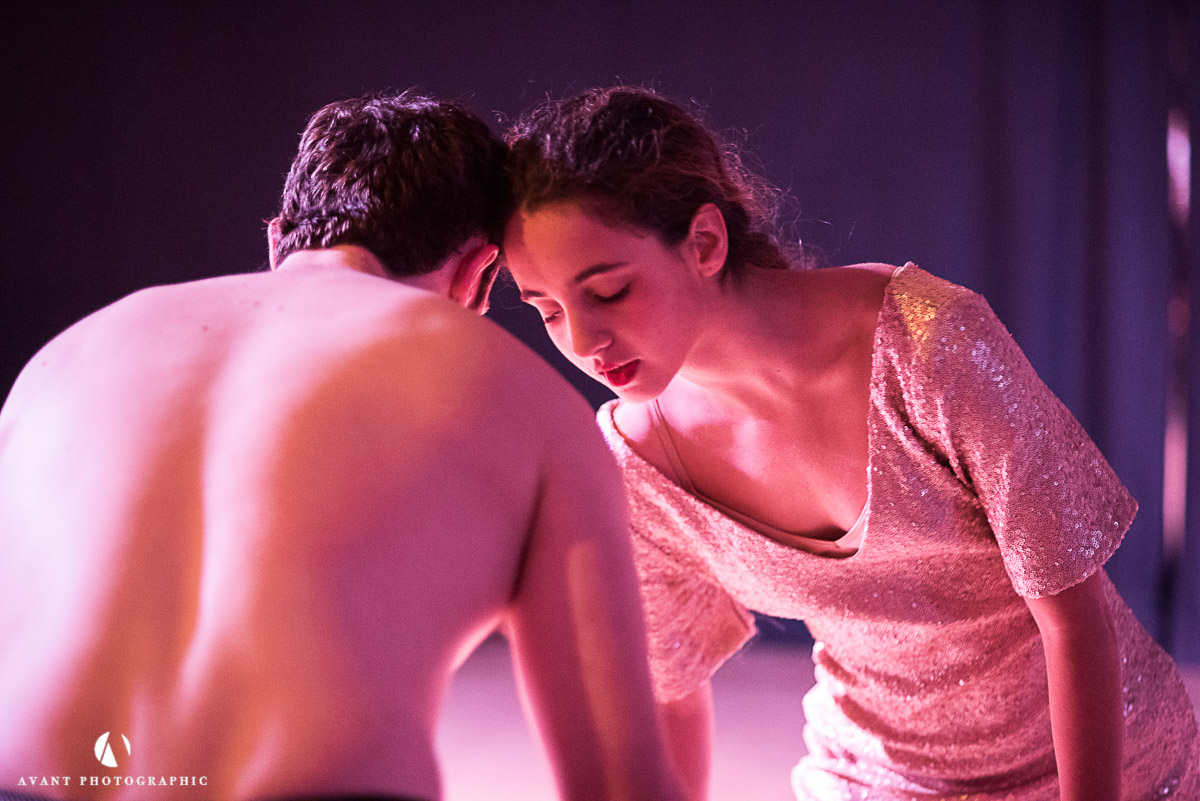
For the past two decades, I have spent a lot of time thinking about gentrification and regeneration. I’ve seen a lot of it happen, unfolding before my eyes, before anyone understood what gentrification was in the States and when regeneration was a government agenda in the UK.
I was living in New York City in the late 90s when gentrification started to take hold. Mayor Rudy Giuliani and his developer buddies started ‘cleaning up’ Time Square and making the West Village ‘family friendly’. At the same time Giuliani wiped out rent control and started closing down nightclubs. Journalists called it the ‘Disneyfication’ of Manhattan.
Fast forward to 2017. Historic West Harlem, long home to New York’s African-American community and the centre of jazz, is becoming less Black as Columbia University buys up more property. Downtown, local residents in Chinatown are staging regular demonstrations against the gentrification that is threatening their homes, businesses and communities.
In the UK, I’ve watched small towns such as Oxford whose working class, diverse communities seemed to smarten up overnight with pubs and shops ‘going up market’, while in London, Soho and Brixton have seen whole swathes of council residents moved out, new buyers moving in.
The latest trend of ‘art washing’ is yet another layer to add further insult to communities – and to art and artists.
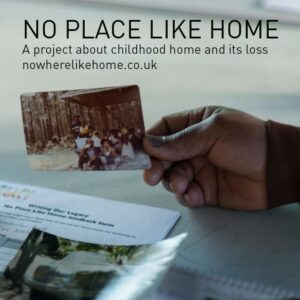 Two years ago, I started working on an art project called No Place Like Home that explores childhood home, starting with the destruction of my own childhood Mexican-American community in Austin, Texas.
Two years ago, I started working on an art project called No Place Like Home that explores childhood home, starting with the destruction of my own childhood Mexican-American community in Austin, Texas.
I was fortunate enough to receive funding through Artists’ International Development Fund (AIDF), an Arts Council England and British Council initiative.
The funding allowed me to conduct two weeks of serious research in Austin, documenting my community in a way I had never done before to create a film and a collection of short stories based on the research.
It was a tough and heart-wrenching experience as I interviewed over 25 Mexican-American residents, some of whom lost their home due to being priced out or through the rapid changes that gentrification was making on downtown Austin.
The project made me question who I was as a person and the choices I had made in life.
Firstly, I had to confront the epic transformation of downtown. From a ghettoised no-go area where only Mexican-American and African-American citizens lived since the 1930s, it has become a playground for the tech industry, SXSW, yuppies and tourists. It was no longer home to me.
Secondly, I had to come to terms with my emotions about my heritage and the institutional racism and discrimination experienced by my people. There were many times when interviewing that I had to fight back my tears at the injustice and inhumanity.
Lastly, throughout my research, I was reminded repeatedly that I had left Austin and never came back. Before I started my AIDF research, I felt I was on one side of the fence: with the Mexicanos, the poor, the defeated, my family, people from the East Side, the barrio.
But during those hot June weeks, I wasn’t sure anymore where I fit in. I didn’t seem to belong on either side. Was I the defector? Did I belong in Austin anymore?
This rattled through my head as I wandered around Rainey Street’s downtown food trucks, festival-like markets, bulldozed housing lots, and expensive high-rise condos, where even one of my friends lived. All around me, downtown – the barrio – was infiltrated by yuppies, corporates, you know…..people with spare money.
When I came back home to the UK, I questioned myself further: where did I stand in the regeneration game here?
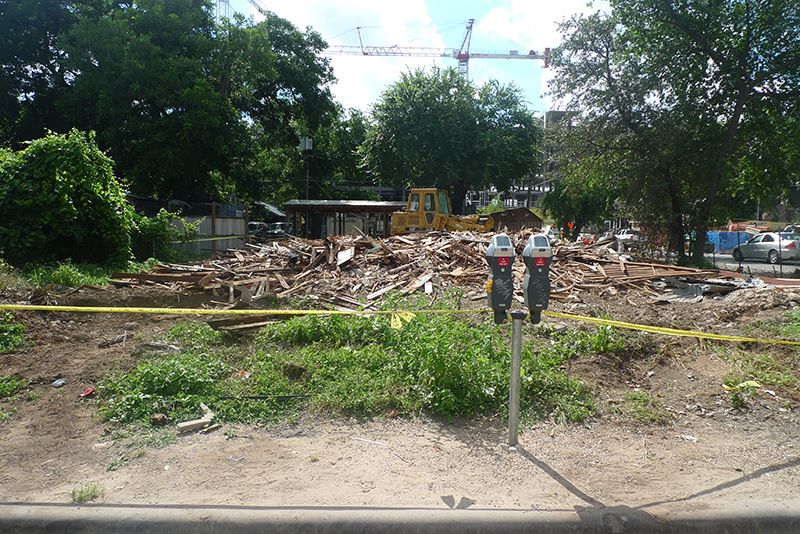
In the 2000s, I was involved in Brighton’s grassroots scene as a community development worker, working in the city’s most deprived neighbourhoods. I volunteered with diverse communities and worked on numerous projects to help local people have a voice.
But was that enough?
The answer: it always come back to the people and communities. Their stories, memories, heritage, history and culture. It has meaning and value. It’s people’s home. I realised it’s okay to be a newcomer if you take the time to learn about the local community and find a way to contribute.
I am hopeful for Eastbourne’s Seaside Road and Seaside regeneration.
Already there is an inspiring and active artist network and a colourful local business community, all who want to get involved. There is a lot of passion and good will to make art and make a difference.
The groundwork is being laid for artistic, cultural and heritage renaissance for the Devonshire Ward, I can feel it.

Thoughts on how to prevent gentrification and ghettoisation:
• Don’t just be a consumer: play a part, volunteer, listen to people’s stories and memories, be an active resident, be an activist – or like many Devonshire Collective members, be an art activist!
• Fight for affordable housing. Talk to your local council about what the provision is for your area.
• Be willing to cross geographical boundaries. There is no such thing as a ‘bad part of town’. There are hidden gems in poor neighbourhoods and hidden pockets of deprivation in more ‘affluent’ neighbourhoods. Be inclusive or you could be missing out on opportunities to experience authentic culture and exciting new art.
• Don’t let gentrification just happen, be part of the change, be positive, do something. Make art. Protest. Make a difference. Get involved, ask questions. Collectively, people can make a bigger change together than they can alone.

You can follow and contribute your stories of your childhood home to the No Place Like Home project or on Facebook.
Twitter handles for this article: @amyzsolis; @bhwritinglegacy; @dev_collective
For articles about gentrification and urban regeneration copy and paste these URLs:
https://www.theguardian.com/artanddesign/jonathanjonesblog/2016/jul/18/artwashing-new-watchword-for-anti-gentrification-protesters
https://www.theguardian.com/housing-network/2016/may/13/hipsters-artists-gentrification-social-cleansing-developers
Next week I interview textile artist Jane Charles, whose quilts have been chosen for major displays at the National Exhibition Centre and around Europe.
ABOUT LESLIE TATE’S BOOKS:

I interviewed writer Julia Lee Barclay-Morton about her experience of autism. Julia began as an experimental dramatist in New York, moving to the UK to

I interviewed Gillean McDougall from Glasgow, who edited the collaborative projects Honest Error (on Charles Rennie Mackintosh and his wife Margaret Macdonald) and Writing the

I interviewed French writer Delphine de Vigan, whose book, No et moi, won the prestigious Prix des libraires. Other books of hers have won a clutch

I interviewed Joanne Limburg whose poetry collection Feminismo was shortlisted for the Forward Prize for Best First Collection; another collection, Paraphernalia, was a Poetry Book Society Recommendation. Joanne

I interviewed Katherine Magnoli about The Adventures of KatGirl, her book about a wheelchair heroine, and Katherine’s journey from low self-esteem into authorial/radio success and
| Cookie | Duration | Description |
|---|---|---|
| cookielawinfo-checkbox-analytics | 11 months | This cookie is set by GDPR Cookie Consent plugin. The cookie is used to store the user consent for the cookies in the category "Analytics". |
| cookielawinfo-checkbox-functional | 11 months | The cookie is set by GDPR cookie consent to record the user consent for the cookies in the category "Functional". |
| cookielawinfo-checkbox-necessary | 11 months | This cookie is set by GDPR Cookie Consent plugin. The cookies is used to store the user consent for the cookies in the category "Necessary". |
| cookielawinfo-checkbox-others | 11 months | This cookie is set by GDPR Cookie Consent plugin. The cookie is used to store the user consent for the cookies in the category "Other. |
| cookielawinfo-checkbox-performance | 11 months | This cookie is set by GDPR Cookie Consent plugin. The cookie is used to store the user consent for the cookies in the category "Performance". |
| viewed_cookie_policy | 11 months | The cookie is set by the GDPR Cookie Consent plugin and is used to store whether or not user has consented to the use of cookies. It does not store any personal data. |
3 responses
A very interesting post, Leslie and Amy. I enjoyed learning about arts-led regeneration in these areas.
Yes, I imagine it’s rather different to South Africa! Amy is widely-experienced and really knows what she’s talking about.
Hi Robbie, thank you so much for the comment & sorry about the late reply. That arts job in Eastbourne keeps me busy, especially as the weather warms up! If you’d ever like to come visit, you’d be very welcome. Happy to arrange a tour of our 3 venues.